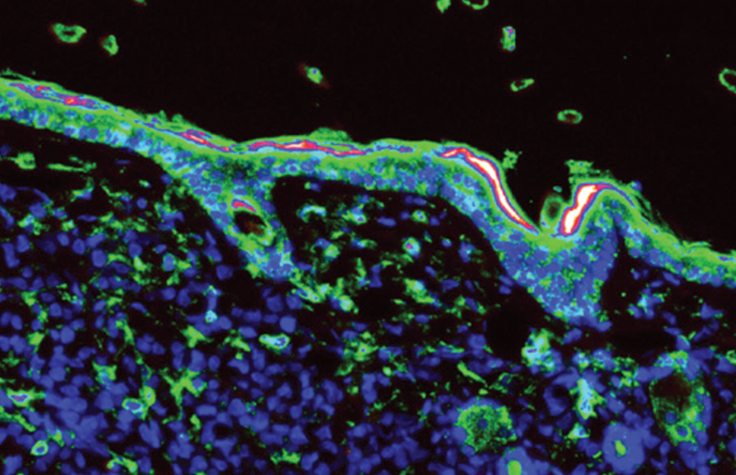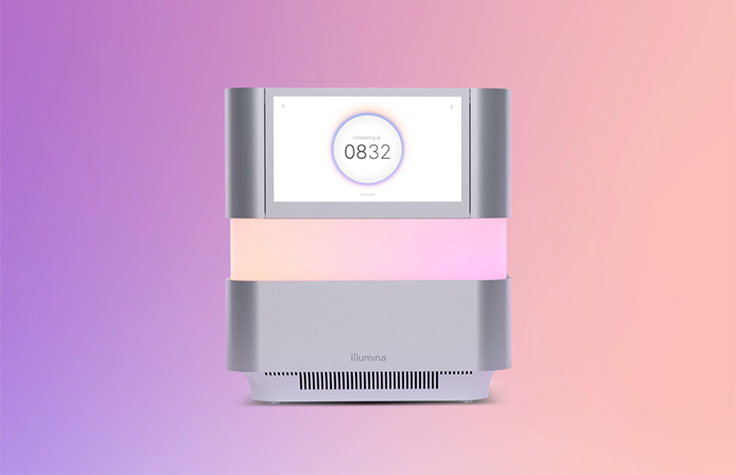Spatial Transcriptomics

What is Spatial Transcriptomics?
Spatial transcriptomics provides a comprehensive roadmap of transcriptional activity within intact tissue sections. Depending on the approach, this method can detect transcriptional activity using hybridization techniques or RNA sequencing (RNA-Seq) technology powered by next-generation sequencing (NGS) with high sensitivity. Spatial transcriptomics allows researchers to accurately resolve mRNA expression at the cellular level in structurally preserved tissues.
Spatial Transcriptomics of Complex Tissues
Learn about high-resolution, high-throughput spatial transcriptomics of kidney tissues using the NanoString GeoMx Digital Spatial Profiler and Illumina sequencing systems.
Benefits of Spatial Transcriptomics
A key benefit of spatial transcriptomics is that it provides a topographical arrangement of gene expression patterns mapped onto tissue sections to link structure and activity. This capability allows researchers to articulate biological interactions at the cellular level to gain novel insights into complex tissues such as tumor microenvironments, as well as to chart cellular activity in normal vs. diseased tissues, create quantitative atlases of cell activity, and beyond.
Traditionally, immunohistochemistry (IHC) and in situ hybridization have been the tools of choice to reveal spatial gene expression in tissue sections. But the throughput of these methods is limited, analyzing only a few genes at a time. By combining high-throughput imaging and sequencing, spatial transcriptomics with RNA-Seq provides a previously inaccessible view of the transcriptome in morphological context. Spatial RNA-Seq methods that retain the precise location of biological molecules in tissue samples can further our understanding of mechanisms in health and disease.
How Does Spatial Transcriptomics Work?
To spatially resolve mRNA expression in tissue sections, transcripts from sectioned frozen or formalin-fixed, paraffin-embedded tissues are either captured on slides using spatially localized probes or are detected directly in specific regions of interest using photoactive in-situ hybridization probes. cDNA libraries are sequenced and analyzed to quantify expression levels. Depending on the method of choice, expression of 1,200–21,000 protein-coding genes can be quantitatively analyzed in a single readout and accurately mapped to provide transcriptional information on tissue sections.
Transcriptional Profiling of Tissue Sections
Leverage Visium Spatial Gene Expression from 10x Genomics for transcriptional profiling of entire tissue sections.
The Power of Multiomics
Download our in-depth eBook on how multiomic methods have revolutionized research through cutting-edge sequencing and array technology.
A Multiomic Approach to Spatial Biology
Spatial biology can incorporate other analytical methods such as epigenomic, genomic, and proteomic information at the cellular level while similarly providing contextual information within preserved tissues. These methods collectively fall under the term spatial multiomics and offer a multidimensional approach to comprehensively understand biological systems. For many spatial multiomic applications, Illumina offers NGS-powered technologies that can link structural, functional, and spatial insights to enable your next discoveries.

Whole-transcriptome analysis in intact tissue sections
Illumina spatial technology allows for hypothesis-free analysis of gene expression profiling on an advanced substrate. This design also allows easy application of the technology across any eukaryotic species.
Learn more about Illumina spatial transcriptomics technologySpatial Transcriptomics Workflow
From sample to discovery, Illumina instruments offer integration with partnered solutions for a reliable, scalable, sensitive spatial RNA-Seq workflow.
Prepare Samples
Section and prepare fresh frozen or formalin-fixed, paraffin-embedded tissues onto slides.
10x Genomics Visium CytAssist for FFPE Tissues
10x Genomics Visium Spatial Gene Expression for FFPE
Profile and Construct Libraries
Image and construct libraries for sequencing steps.
NanoString GeoMx Protein Assays
NanoString GeoMx Whole Transcriptome Atlas
NanoString GeoMx Digital Spatial Profiler
10x Genomics Visium Spatial Gene Expression
10x Genomics Visium Spatial Proteomics
Sequence
Perform sequencing using Illumina instruments.
NovaSeq X Series
NovaSeq 6000 System
NextSeq 1000 or 2000 System
Analyze
Visualize
Visualize and map gene expression to tissue location.
Illumina Connected Multiomics
DRAGEN GeoMx NGS Pipeline
10x Genomics Loupe Browser
Highlighted Solutions
Sequencing Instruments
Compare Illumina sequencing instruments by application, throughput, and other key specifications, and determine which platform is right for your needs.
Single-Cell and Spatial Sequencing on NextSeq 1000 and 2000 Systems
Learn how XLEAP-SBS chemistry combined with 10x Genomics single-cell and spatial solutions enable high-resolution genomics on the NextSeq 1000 and NextSeq 2000 Systems.
Spatial RNA-Seq Data Analysis with Illumina Connected Multiomics
Illumina Connected Multiomics software provides an easy‑to‑use interface, advanced statistical algorithms, and rich interactive visualizations for spatial transcriptomics analysis. Characterize gene and protein expression in their native spatial context or analyze and integrate other data types.
Featured Webinars
Resolving Dynamic Microenvironments in Cancer Research
Learn how NGS-based solutions and NanoString’s GeoMx assays deliver deep insights into tumors and microenvironments.
Building a Tumor Immune Atlas
Watch how researchers link tissue morphology and biological activity to create a reference atlas for tumor pathology.
Spatial Resolution of the Developing Human Cortex
See how scientists are using 10x technologies, single-cell RNA-Seq, and Visium with Illumina sequencing to reveal the spatial resolution of the developing human fetal cortex.
Advances in Spatial Biology and Cancer Research
Scientific experts highlight the historic journey of cancer research using solutions from NanoString and Illumina from a spatial biology perspective.
Spatiotemporal Changes in Cardiac Tissue
Learn about transcriptional changes in different regions of cardiac tissue during early-onset acute myocardial infarction.
Single-Cell Transcriptomic Landscape in Alzheimer’s
See how Dr. Vivek Swarup’s application of spatial transcriptomics has led to advancements in understanding late-stage Alzheimer’s diease.
Explore NextSeq 1000 and NextSeq 2000 Systems and Reagents
With over 75 breakthrough innovations, these sequencing systems offer dry instrumentation, easier run setup, and fast secondary analysis with DRAGEN software onboard. Experience our simplest workflows yet, and perform a broad range of emerging and mid-throughput sequencing applications.
Learn More
Featured Customer Research and Publications
Visualizing Cell Interactions
Read how researchers used spatial insights to add another dimension to their single-cell transcriptomic data.
Understanding the Tumor Microenvironment
Read how the tumor microenvironment can provide essential clues about the behavior of diseased cells.
Precision Immunotherapies
Read how a three-pronged analytical approach is helping researchers identify promising immune targets for cancer immunotherapies.
Sequencing-Based Spatial Genomic Analysis
Learn how spatial multiomic profiling can provide unprecedented molecular information in cancer biopsy samples.
Future of Multiomic Research
Read how spatial information is providing next-generation improvements in multiomic data for cancer research.
Research Highlights Using Spatial Transcriptomics
Immunological Atlas
Read how investigators use spatial transcriptomics to create an atlas of developing immune systems in humans.
Read PaperUnderstanding the Ovarian Tumor Microenvironment
Learn how researchers use spatial transcriptomics to identify differences in ovarian cancer microenvironments, gene expression, and therapeutic responses.
Read PaperSpatially Mapping Diverse Tissues
See how scientists discovered the spatial layout of diverse cells in various tissues using spatial transcriptomics.
Read PaperRelated Content
Multiomics
Want to learn how you can integrate multiple levels of data into your research? Find out how multiomics can provide a more comprehensive understanding of biological systems.
Cell & Molecular Biology
We offer technologies to go beyond traditional cell and molecular biology research techniques so you can harness the power of genomic, transcriptomic, and epigenomic data efficiently and accurately.
Single-Cell RNA Sequencing
Single-cell RNA sequencing can provide solutions to unravel complex biological systems at high resolution with minimal sample input.
FFPE RNA-Seq From Degraded Tissues
Get high-quality results from formalin-fixed, paraffin-embedded (FFPE) tissues using Illumina RNA-Seq solutions.
NGS in Cancer Research
Your methods guide for NGS-based applications in cancer research, including spatial transcriptomics, is available now.
Single-Cell Workflow Guide
Download our eBook guide and learn how to enable higher discovery power through single-cell sequencing.
Gene Expression and Regulation Research Guide
See how Illumina RNA-Seq solutions can empower transcriptomic and epigenetic methods to advance discoveries in biology.
Introduction to Transcriptomics
See how a comprehensive view of transcriptional activity (coding and non-coding) can help you get a deeper understanding of biology using NGS-based RNA-Seq.
Spatial Proteomic and Proteogenomic Insights
Combine the spatial analyses of RNA and protein using the Nanostring GeoMx DSP and Illumina sequencing to understand the heterogeneous pathology of human astrocytoma and glioblastoma samples.